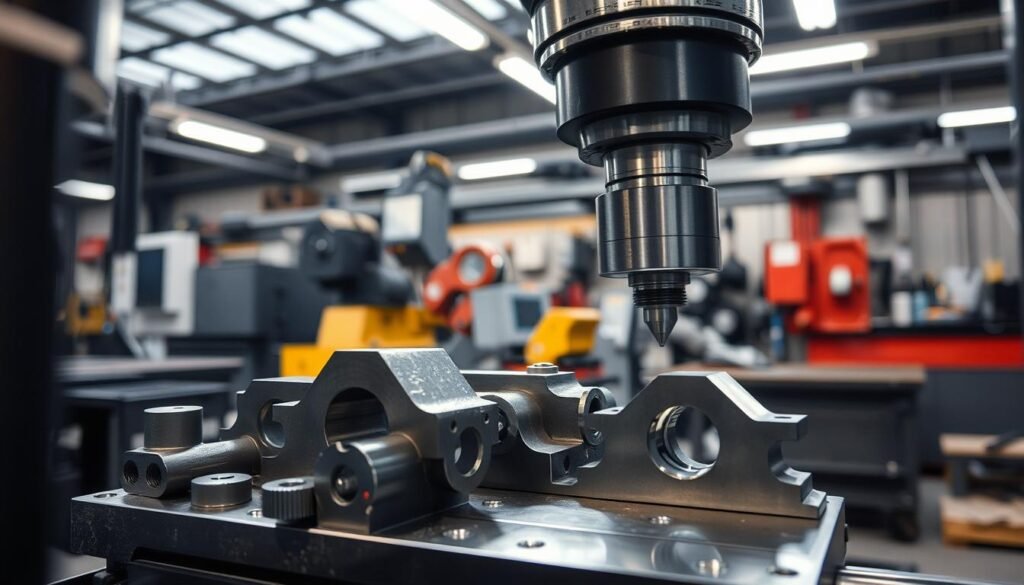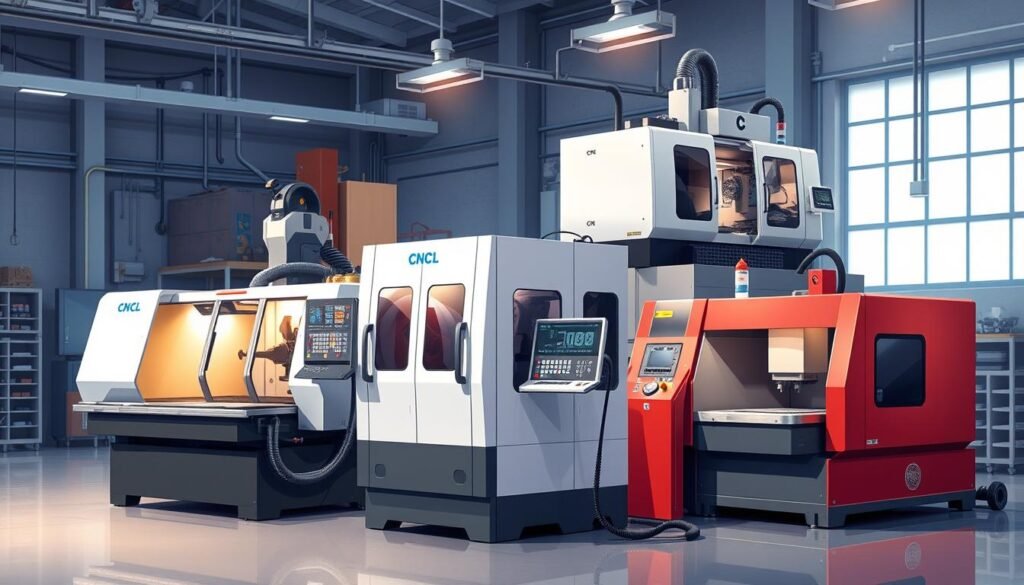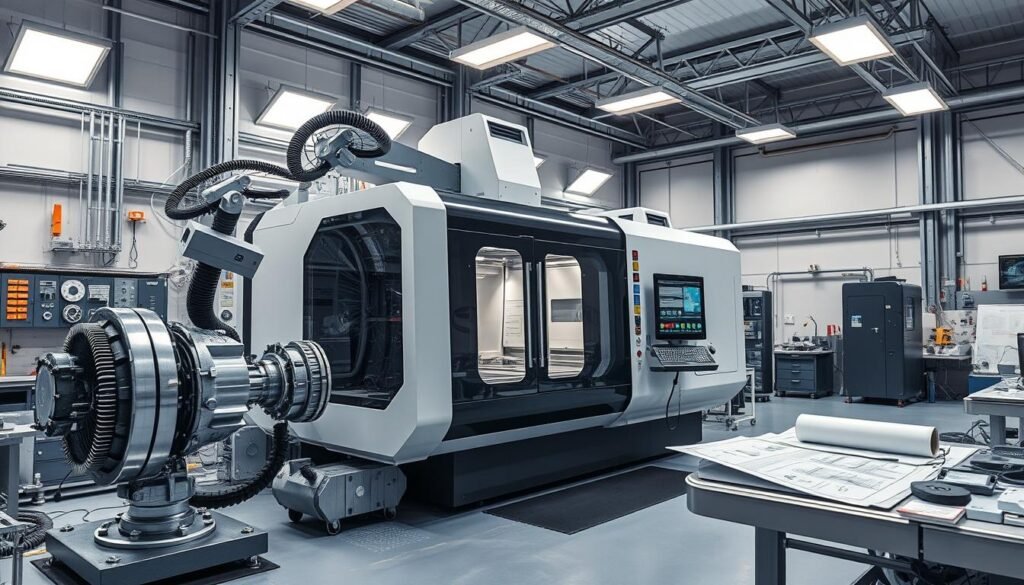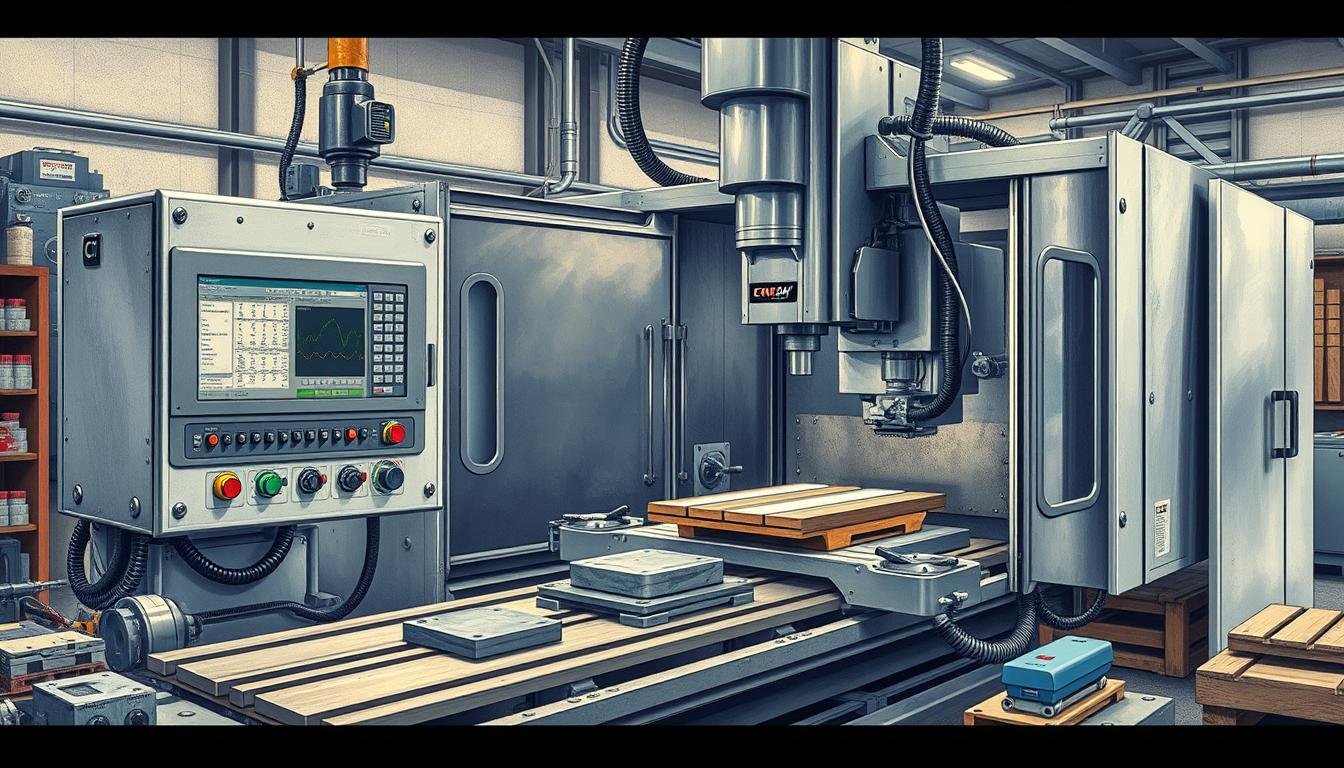¿Alguna vez se ha preguntado cómo se fabrican las minuciosas piezas de la industria aeroespacial, los dispositivos médicos o los ordenadores portátiles? Se fabrican con una precisión asombrosa.
Sumerjámonos en Fundamentos del mecanizado CNCsu tecnología y su papel clave en ingeniería de precisión. Saber qué significa CNC es crucial. Nos muestra cómo esta tecnología cambia la fabricación. Aporta precisión y eficiencia.
Principales conclusiones
- El mecanizado CNC puede conseguir tolerancias de tan sólo 0,00004 pulgadas, cruciales en campos como el aeroespacial.
- La industria del automóvil confía en el CNC para producir componentes de alta precisión.
- Apple utiliza unas 10.000 máquinas CNC para la producción a gran escala de sus portátiles.
- La industria médica experimentó un aumento de la producción de CNC durante la pandemia de COVID-19.
- Las máquinas CNC reducen considerablemente el desperdicio de material y mejoran la eficacia de la producción.
- Las aleaciones de alto rendimiento, como Inconel y Kovar, se utilizan en el mecanizado aeroespacial CNC.
Introducción al mecanizado CNC
El mecanizado CNC es una parte fundamental de la fabricación moderna. Utiliza herramientas como amoladoras, tornos, fresadoras y routers. Estas herramientas realizan cortes en 3D con un único juego de órdenes. En Proceso CNC automatiza las operaciones, reduciendo el trabajo humano. También aumenta la eficiencia y hace que las cosas sean iguales en la fabricación.
Tecnología CNC ha crecido mucho, y ahora la mayoría de los sistemas están automatizados. Utilizan software CAD y CAM para fabricar mejor las piezas. Esta mezcla de software y herramientas en la fabricación automatizada garantiza más precisión y gran eficacia. Es mejor que la antigua forma de hacer las cosas a mano.
Las fresadoras CNC funcionan con un sistema de tres ejes (X, Y, Z). Algunos modelos nuevos añaden hasta tres ejes adicionales para una fabricación más detallada. Por otro lado, los tornos CNC utilizan dos ejes (X y Z). Esto les permite realizar diseños detallados con rapidez y gran precisión. Esta forma avanzada de trabajar cambia nuestra forma de ver y manejar la fabricación de cosas. Destaca el gran papel del CNC en la fabricación automatizada.
También tenemos que hablar de formas especiales de fabricación como la electroerosión por hilo y el corte por chorro de agua. La electroerosión utiliza chispas para cortar materiales conductores con gran precisión. Por su parte, las cortadoras por chorro de agua utilizan agua a alta presión para cortar sin calor. Esto es ideal para muchos usos.
En resumen, el CNC ha cambiado la fabricación al ofrecer gran precisión, eficacia y flexibilidad. Hace lo que la fabricación manual no puede. A medida que conozcamos mejor el CNC, veremos cómo satisface las complejas necesidades de fabricación actuales.
¿Qué significa CNC en el mecanizado?
CNC significa Control Numérico por Ordenador. Se trata de una tecnología clave que permite controlar las máquinas mediante software. Nuestro objetivo es comprender mejor El papel del CNC en el mundo manufacturero actual.
Conocer el CNC es esencial. Esta tecnología ofrece muchas ventajas:
- Exactitud y precisión: La maquinaria CNC consigue una gran precisión, reduciendo los errores y el desperdicio de material.
- Eficacia y rapidez: El CNC aumenta la velocidad de producción, con un ahorro de tiempo de hasta 80%. Las máquinas funcionan sin parar, lo que aumenta la producción.

- Flexibilidad: Estas máquinas trabajan con muchos materiales y diseños intrincados, que el trabajo manual considera un reto.
Las máquinas CNC tienen de 3 a 6 ejes de movimiento, lo que aumenta su capacidad y la complejidad que pueden manejar. Por ejemplo, los tornos CNC estándar tienen ejes X y Z. Las versiones más recientes incluyen más ejes para tareas avanzadas. Las versiones más recientes incluyen más ejes para tareas avanzadas.
El impacto del CNC va más allá de las operaciones básicas. Desde la primera máquina CNC en 1952, la fabricación ha experimentado importantes mejoras. Hoy en día, la combinación de la fabricación aditiva y sustractiva con CNC aumenta tanto la eficiencia como la productividad. y precisión.
Cómo funcionan las máquinas CNC
El mecanizado CNC mejora la precisión de fabricación y aumenta la productividad hasta 50%. Pero, ¿qué hace que estas máquinas sean tan eficaces? Exploremos las piezas y los procesos que hay detrás de su éxito.
El papel de los programas informáticos
El corazón de las máquinas CNC es Software CNC. Este software convierte los modelos CAD en código G. El código G controla las piezas de la máquina. Este paso, denominado programación de máquinas CNCgarantiza que las tareas se realicen con precisión. Facilita los trabajos complejos, lo que permite una producción más rápida y uniforme.
Componentes importantes de la máquina
Para que una máquina CNC funcione se necesitan varias piezas fundamentales. Éstas son las principales:
- Controlador: Es el cerebro de la máquina CNC. Procesa todos los comandos de programación.
- Sistema de transmisión/motor: Este sistema mueve los ejes de la máquina.
- Huso: El husillo realiza el trabajo de mecanizado propulsado por el sistema de accionamiento.
- Cama de la máquina: Proporciona una base estable tanto para la pieza de trabajo como para cualquier movimiento durante el funcionamiento.
- Cambiador de herramientas: Este componente permite cambiar de herramienta automáticamente.
Estos Componentes CNC todos trabajan juntos para lograr un mecanizado eficaz. Las fresadoras CNC, a menudo más costosas, ofrecen opciones avanzadas como configuraciones de tres a seis ejes. Esto permite una amplia gama de posibilidades de mecanizado.
Código G y código M
El código G es el lenguaje básico para Programación CNC. Garantiza que las máquinas sigan las instrucciones con precisión. Código M gestiona funciones adicionales, como el cambio de herramientas o el control del refrigerante. Estos códigos permiten a los operarios controlar con precisión el proceso de mecanizado. Mejoran el uso del material y la eficacia.
Utilizando Código G y código M derecho puede reducir los residuos de producción en un 30-40%. Esto demuestra lo crucial que es la programación CNC en la fabricación moderna.
| Componente | Función | Notas |
|---|---|---|
| Controlador | Procesa los comandos de programación | El cerebro de la máquina CNC |
| Sistema de accionamiento/motor | Potencia el movimiento de los ejes | Clave para un mecanizado preciso |
| Eje | Realiza tareas de mecanizado | Crítico para las acciones de corte |
| Cama de la máquina | Base estable para la pieza de trabajo | Garantiza la estabilidad durante el funcionamiento |
| Cambiador de herramientas | Cambia de herramienta automáticamente | Mejora la eficacia del flujo de trabajo |
La versatilidad de las máquinas CNC es evidente, ya que son capaces de producir piezas con tolerancias ajustadas de ±0,001 pulgadas. Son clave en industrias que necesitan alta precisión.
Diferentes tipos de máquinas CNC
Hoy en día se utilizan muchas máquinas CNC en la fabricación. Cada tipo ofrece características y ventajas únicas para fabricar diversos artículos.

Las fresadoras CNC son cruciales para fabricar piezas. Utilizan herramientas como fresas para el corte. Estas máquinas pueden tener tres o más ejes, lo que permite realizar cortes diversos y precisos. Cuestan entre $10.000 y más de $200.000, con tarifas por hora que oscilan entre $40 y $200.
Los tornos CNC son excelentes para piezas que son iguales en todos los lados, como los árboles de levas. Son muy precisos y alcanzan tolerancias de hasta ±0,005 pulgadas. Estas máquinas cuestan a partir de $15.000 y alrededor de $40 la hora de funcionamiento.
Las taladradoras CNC son importantes para hacer agujeros precisos. Se utilizan en muchos campos, como la automoción y la fabricación de muebles. Son excelentes para reducir los residuos, lo que las hace muy eficientes.
Las fresadoras CNC trabajan con muchos materiales y aumentan la productividad en 50%. Los precios oscilan entre $3.000 y $100.000. Esto las convierte en una buena opción para muchas necesidades de fabricación diferentes.
Máquinas CNC de corte por plasma trabajan con materiales conductores de la electricidad. Pueden cortar muy rápido, a más de 100 pulgadas por minuto. El precio de estas máquinas oscila entre $12.000 y $300.000 y su funcionamiento cuesta alrededor de $20 por hora.
Las máquinas de corte por láser utilizan láseres de CO2 para cortar artículos no metálicos con gran rapidez. Pueden trabajar con materiales de hasta 0,75 pulgadas de grosor. Los precios empiezan en $5.000 y pueden llegar hasta $300.000, con unos costes operativos de $20 por hora.
Las máquinas de corte por chorro de agua son conocidas por su flexibilidad. Pueden cortar diversos materiales, como caucho, vidrio y metales. Son ideales para hacer formas complejas.
Las máquinas CNC de electroerosión (EDM) son conocidas por su trabajo detallado. Pueden alcanzar una precisión de ±0,0001 pulgadas. Estas máquinas son cruciales para tareas de precisión y su funcionamiento cuesta alrededor de $25 la hora.
Las rectificadoras CNC son esenciales para fabricar piezas con tolerancias muy ajustadas. Se utilizan para tareas de alta precisión, como la fabricación de rodamientos de bolas. Estas máquinas son fundamentales para fabricar componentes de alta calidad.
Para los equipos CNC, la facilidad de reparación y acceso a las piezas es clave. Los talleres con menos de 10% de tiempo de inactividad pueden ahorrar mucho en costes de producción.
| Tipo de máquina | Coste inicial | Coste por hora | Característica principal |
|---|---|---|---|
| Fresado CNC | $10,000 – $200,000+ | $40 – $200 | Varía de 3 ejes a multieje |
| Torno CNC | $15,000+ | $40 | Tolerancias de hasta ±0,005 pulgadas |
| Taladrado CNC | N/A | N/A | Reducción eficaz de los residuos de virutas |
| Fresadora CNC | $3,000 – $100,000 | $40 | Mayor productividad gracias a 50% |
| Corte por plasma CNC | $12,000 – $300,000 | $20 | Velocidades superiores a 100 pulgadas por minuto |
| Corte por láser CNC | $5,000 – $300,000 | $20 | Velocidades de hasta 1000 pulgadas por minuto |
| Corte por chorro de agua CNC | N/A | N/A | Versatilidad en la manipulación de materiales |
| CNC de descarga eléctrica | $15,000+ | $25 | Precisión de ±0,0001 pulgadas |
Saber sobre tipos de máquinas CNC y Variedades de máquinas CNC ayuda a elegir el Equipo CNC. Cada tipo mejora los procesos industriales con precisión, eficacia y flexibilidad.
Industrias que utilizan el mecanizado CNC
El mecanizado CNC es vital en muchas industrias por su precisión, velocidad y flexibilidad. Veamos las principales áreas en las que Tecnología CNC es crucial.
Aeroespacial y automoción
El sector aeroespacial necesita CNC por su extrema precisión, que permite alcanzar tolerancias tan ajustadas como ±0,0001". Este nivel de precisión es fundamental para la seguridad y el funcionamiento de las aeronaves. En el campo de la automoción, el CNC se utiliza desde la creación de prototipos hasta la producción a gran escala. Esto permite fabricar piezas complejas para motores y automóviles.

Médico y dental
En el campo médico, el CNC es esencial para fabricar prótesis articulares y herramientas quirúrgicas. La precisión es la clave. Para piezas dentales como coronas y puentes, el CNC garantiza que encajen perfectamente. El CNC también ayuda a crear implantes médicos trabajando con materiales especiales.
Fabricación general
El CNC se utiliza ampliamente en la fabricación general de diversos productos. Esto incluye electrónica de consumo, muebles e incluso instrumentos musicales. Ayuda en todo, desde la creación rápida de prototipos hasta la producción en serie. Esta flexibilidad ayuda a gestionar el inventario y reducir costes, por lo que es muy popular entre los fabricantes.
| Industria | Aplicaciones | Tolerancias y precisión |
|---|---|---|
| Aeroespacial | Piezas aeronáuticas críticas | ±0.0001" |
| Automoción | De la creación de prototipos a la producción en serie de componentes de motores | Alta precisión |
| Médico y dental | Prótesis articulares, instrumentos quirúrgicos, prótesis dentales | Tolerancias muy estrictas |
| Fabricación general | Electrónica de consumo, muebles, instrumentos musicales | Varía según la aplicación |
Ventajas y aplicaciones del mecanizado CNC
Comprender la ventajas del mecanizado CNC es clave en las decisiones de fabricación. La precisión de la tecnología CNC es inigualable, ya que alcanza tolerancias tan pequeñas como 0,004 mm. Esto aumenta significativamente la precisión con respecto a los métodos manuales.
Las máquinas CNC pueden funcionar 24 horas al día, 7 días a la semana, todo el añoaumentando la producción sin tiempos de inactividad. Manejan cualquier tamaño de pedido, de pequeño a grande, mostrando Amplias aplicaciones del CNC en todos los sectores.
El mecanizado CNC aporta eficacia. Los métodos tradicionales son más lentos y dependen del trabajo manual. Las máquinas CNC aceleran la producción y ofrecen plazos de entrega más rápidos. Pueden albergar hasta 30 herramientas, lo que permite cambiar de herramienta rápidamente sin necesidad de cambios manuales.
El mecanizado CNC reduce la necesidad de mano de obra cualificada. Reduce los costes de mano de obra al tiempo que mantiene altos índices de producción. Esto hace que el mecanizado CNC sea rentable, minimice los errores y garantice una calidad constante.
El mecanizado CNC es más seguro y reduce los accidentes laborales. Ofrece una calidad de producto constante a lo largo de muchos ciclos, hasta que se realizan cambios manualmente.
Las simulaciones digitales evalúan los diseños antes de realizarlos. Esto ahorra tiempo y recursos. La formación en CNC puede ser virtual, lo que reduce los costes de formación.
Las máquinas CNC requieren poco mantenimiento. Sólo necesitan una limpieza ligera y cambios ocasionales de herramientas. Un trabajador cualificado puede gestionar varias máquinas CNC, a diferencia del mecanizado tradicional, que requiere una persona por máquina.
- Las máquinas CNC crean piezas complejas mejor que los métodos manuales, lo que aumenta la productividad y la uniformidad.
- Necesitan menos herramientas para los mismos trabajos en comparación con los métodos tradicionales.
- Son excelentes para la producción a gran escala, pero pueden resultar menos rentables para pequeñas tiradas.
- Las máquinas CNC trabajan con muchos materiales, incluidos metales y plásticos.
- Van desde sistemas de dos ejes a sistemas avanzados de cinco ejes para detalles y ángulos intrincados.
Utilización del mecanizado CNC significa lugares de trabajo más seguros al minimizar las tareas de riesgo para los trabajadores. Gracias a su alta velocidad de producción, suministra de forma eficiente grandes cantidades de piezas.
Las máquinas CNC gestionan con facilidad la complejidad del diseño y los grandes volúmenes. La automatización reduce el tiempo de trabajo manual, por lo que el CNC es esencial en la fabricación moderna.
Conclusión
El mecanizado CNC es clave en el mundo de la fabricación actual. Ofrece una precisión y eficacia inigualables. Estas máquinas pueden trabajar con una precisión extrema, de hasta ±0,001 pulgadas. Esto significa que los productos siempre cumplen altos estándares.
Además, la integración CAD/CAM aumenta la productividad. Combina a la perfección el software de diseño con el mecanizado. Esto acelera la fabricación de los productos.
La tecnología CNC mejora constantemente. Ahora las máquinas pueden trabajar en cinco ejes, lo que supuso un gran avance. Además, más del 60% de las máquinas CNC son ahora inteligentes. Pueden conectarse a Internet, lo que las hace más eficientes.
En los años 90, el mundo del CNC era diferente. Se utilizaban controles basados en PC. Ahora tenemos sistemas mucho más avanzados. Esto demuestra lo mucho que se ha innovado.
El mecanizado CNC aumenta la productividad en 50% gracias a la automatización. Muchas empresas recuperan la inversión en un año. Las máquinas pueden trabajar rápido, hasta 200 pulgadas por minuto. Esto reduce los errores y casi los elimina por completo.
Por fin, Tecnología CNC es crucial para fabricar cosas hoy y en el futuro. Impulsa la innovación. Es esencial para fabricar productos en un entorno moderno.
PREGUNTAS FRECUENTES
¿Qué es el mecanizado CNC?
El mecanizado CNC utiliza máquinas controladas por ordenador para fabricar piezas complejas con precisión. Este método es la abreviatura de Control Numérico por Ordenador. En este proceso, el software indica a las herramientas de la fábrica cómo moverse.
¿Qué significa CNC?
CNC significa Control Numérico por Ordenador. Este proceso controla las máquinas herramienta mediante ordenadores. Estas herramientas incluyen fresadoras y tornos. Fabrican artículos precisos como coronas y puentes dentales.
¿Cómo funcionan las máquinas CNC?
Las máquinas CNC siguen instrucciones establecidas para funcionar. El software diseña las piezas y crea el código. Partes importantes de la máquina siga estas instrucciones. Este proceso utiliza código G y Código Mque son lenguajes de programación comunes.
¿Qué tipos de máquinas CNC existen?
Existen muchos tipos de máquinas CNC. Incluyen fresadoras CNC, tornos, fresadoras, cortadoras de plasma y rectificadoras. Cada tipo sirve a diferentes industrias. Estas industrias son la aeroespacial, automotriz, médica, dental y manufacturera.
¿Qué industrias utilizan el mecanizado CNC?
Muchos campos utilizan el mecanizado CNC. Las industrias aeroespacial y automovilística necesitan ingeniería de precisión. Los campos médico y dental fabrican piezas como coronas. Además, la fabricación general utiliza CNC para diversos productos.
¿Cuáles son las ventajas del mecanizado CNC?
Las ventajas del mecanizado CNC son evidentes. Ofrece una gran precisión y fabrica piezas complejas con eficacia. Además, permite una fabricación flexible. Esto reduce los errores y acelera la producción.


